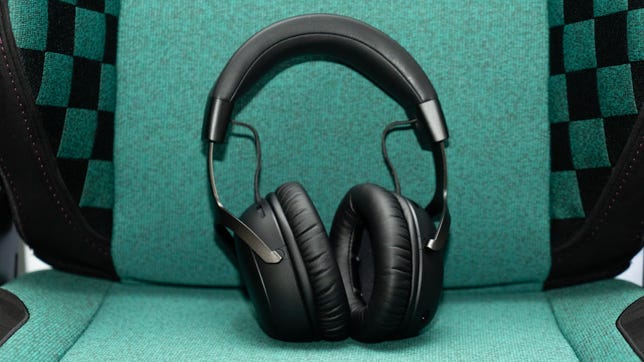Like
Very comfortable
Good battery life
Don’t like
Few features and controls
No wired operation
HyperX’s Cloud line of gaming headsets has long been one of the most comfortable around, and the $170 Cloud 3 Wireless — as well as its much cheaper wired sibling, which I’ve also tested, the $100 Cloud 3 — remain on my short list of headsets that sit lightly on my head. Though a bit bare bones for the money, a criticism I also levied on the Cloud 2 Wireless, which was cheaper than the 3 at launch (though that may be inflation), it’s a bit cheaper than solid competitors like the SteelSeries Arctis Nova 7.
The company has tweaked the features and design in the two years since the last version shipped. It’s still dongle-friendly for any hardware with a USB-C port or a USB-A port via the adapter, notably the PS5 and Nintendo Switch in addition to the PC (the software only runs on Windows).
The new mic is bigger and has a built-in pop filter rather than foam cover.
It also has a much longer battery life. HyperX rates it for 120 hours at 50% volume; 50% is actually kind of high because these can get really loud, so 120 hours may be a conservative estimate. And it drained pretty slowly during testing.
You can get the battery level by tapping the power button. That used to toggle surround sound, and though it still supports DTX Headphone:X, you can only toggle it via the Ngenuity software. You no longer can tap the mute button to toggle mic monitoring. Now that’s also accessible only in software. Though the mute-tap method was prone to accidental mute-tation, I miss hardware control over monitoring.
The detachable mic is bigger, and rather than a foam cover, it has an internal pop filter that does a so-so job — I’ll take it over a so-so foam cover, though. Its sound quality is good for chat, but there are no equalizer controls to tweak it for slightly more formal use. Similarly, you can’t set the volume for mic monitoring, but the default should work for most people. There’s some built-in noise cancellation, but you can’t control the degree, and it doesn’t seem to be aggressive enough.
It has only basic controls: power, mic mute and volume.
The 53mm drivers seem to be the same ones as before, but now they’re angled, in theory to deliver the sound more precisely toward your ear. The software provides a basic 10-point graphic equalizer with a handful of presets and the ability to create custom ones. The DTS surround is usually pretty good but didn’t seem quite as 360-degree here, mostly in the rear channels, and you can’t adjust them at all. The headset does include a lifetime activation for the DTS Sound Unbound app.
They’re not exceptionally sound isolating, just about as much as you expect from leatherette and memory foam — muffled but not silent. Through walls the signal reached about 30 feet before starting to get spotty. Though they charge via USB-C, they don’t operate via USB and there’s no 3.5mm analog jack, which comes in handy when you’re playing a fun game of “is it a dongle or headset fail?”
HyperX remains one of my favorite gaming headset brands, and the Cloud 3 Wireless does a fine job of maintaining the reputation of its Cloud kin — it’s comfortable, with solid audio and battery life. And if you find it on sale, it’s a good deal as well.





